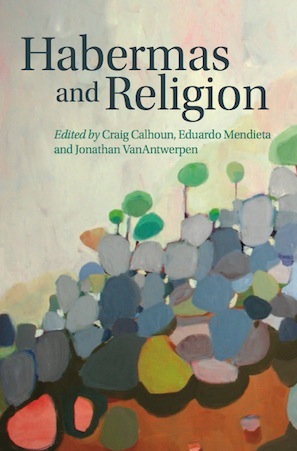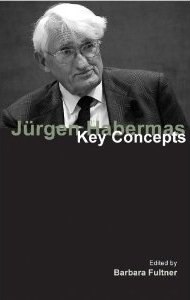 The centrality of religion to social theory in general and philosophy in particular explains why Jürgen Habermas has dealt with it, in both substantive and creative ways, in all of his work. Indeed, religion can be used as a lens through which to glimpse both the coherence and the transformation of his distinctive theories of social development and his rethinking of the philosophy of reason as a theory of social rationalization.
The centrality of religion to social theory in general and philosophy in particular explains why Jürgen Habermas has dealt with it, in both substantive and creative ways, in all of his work. Indeed, religion can be used as a lens through which to glimpse both the coherence and the transformation of his distinctive theories of social development and his rethinking of the philosophy of reason as a theory of social rationalization.
For Habermas, religion has been a continuous concern precisely because it is related to both the emergence of reason and the development of a public space of reason-giving. Religious ideas, according to Habermas, are never mere irrational speculation. Rather, they possess a form, a grammar or syntax, that unleashes rational insights, even arguments; they contain, not just specific semantic contents about God, but also a particular structure that catalyzes rational argumentation.
We could say that in his earliest, anthropological-philosophical stage, Habermas approaches religion from a predominantly philosophical perspective. But as he undertakes the task of “transforming historical materialism” that will culminate in his magnum opus, The Theory of Communicative Action, there is a shift from philosophy to sociology and, more generally, social theory. With this shift, religion is treated, not as a germinal for philosophical concepts, but instead as the source of the social order. This approach is of course shaped by the work of the classics of sociology: Weber, Durkheim, and even Freud. What is noteworthy about this juncture in Habermas’s writings is that secularization is explained as “pressure for rationalization” from “above,” which meets the force of rationalization from below, from the realm of technical and practical action oriented to instrumentalization. Additionally, secularization here is not simply the process of the profanation of the world—that is, the withdrawal of religious perspectives as worldviews and the privatization of belief—but, perhaps most importantly, religion itself becomes the means for the translation and appropriation of the rational impetus released by its secularization. Here, religion becomes its own secular catalyst, or, rather, secularization itself is the result of religion. This approach will mature in the most elaborate formulation of what Habermas calls the “linguistification of the sacred,” in volume two of The Theory of Communicative Action. There, basing himself on Durkheim and Mead, Habermas shows how ritual practices and religious worldviews release rational imperatives through the establishment of a communicative grammar that conditions how believers can and should interact with each other, and how they relate to the idea of a supreme being. Habermas writes:
worldviews function as a kind of drive belt that transforms the basic religious consensus into the energy of social solidarity and passes it on to social institutions, thus giving them a moral authority.
[. . .] Whereas ritual actions take place at a pregrammatical level, religious worldviews are connected with full-fledged communicative actions.
The thrust of Habermas’s argumentation in this section of The Theory of Communicative Action is to show that religion is the source of the normative binding power of ethical and moral commandments. Yet there is an ambiguity here. While the contents of worldviews may be sublimated into the normative, binding of social systems, it is not entirely clear that the structure, or the grammar, of religious worldviews is itself exhausted. Indeed, in “A Genealogical Analysis of the Cognitive Content of Morality,” Habermas resolves this ambiguity by claiming that the horizontal relationship among believers and the vertical relationship between each believer and God shape the structure of our moral relationship to our neighbour, but now under two corresponding aspects: that of solidarity and that of justice. Here, the grammar of one’s religious relationship to God and the corresponding community of believers are like the exoskeleton of a magnificent species, which, once the religious worldviews contained in them have desiccated under the impact of the forces of secularization, leave behind a casing to be used as a structuring shape for other contents.
In the “postmetaphysical” stage of Habermas’s intellectual itinerary, he turns his attention away from sociology and towards philosophy once again, in particular, political and moral philosophy. Metaphysical thinking, which for Habermas has become untenable by the very logic of philosophical development, is characterized by three aspects: identity thinking, or the philosophy of origins that postulates the correspondence between being and thought; the doctrine of ideas, which becomes the foundation for idealism, which in turn postulates a tension between what is perceived and what can be conceptualized; and a concomitant strong concept of theory, where the bios theoretikos takes on a quasi-sacred character, and where philosophy becomes the path to salvation through dedication to a life of contemplation. By “postmetaphysical” Habermas means the new self-understanding of reason that we are able to obtain after the collapse of the Hegelian idealist system—the historicization of reason, or the de-substantivation that turns it into a procedural rationality, and, above all, its humbling. It is noteworthy that one of the main aspects of the new postmetaphysical constellation is that in the wake of the collapse of metaphysics, philosophy is forced to recognize that it must co-exist with religious practices and language:
Philosophy, even in its postmetaphysical form, will be able neither to replace nor to repress religion as long as religious language is the bearer of semantic content that is inspiring and even indispensable, for this content eludes (for the time being?) the explanatory force of philosophical language and continues to resist translation into reasoning discourses.
In contrast to metaphysical thinking, with its overvaluation of philosophy’s power, and thus its belief that philosophy is itself the voice of the truth of being, postmetaphysical thinking would neither dismiss religion as mere myth, and thus as the other of reason, nor assimilate itself to religion, usurping religious language and contents (as with mystical philosophies, such as that of the later Heidegger, with his call for a God who would save us). In other words, metaphysical thinking either surrendered philosophy to religion or sought to eliminate religion altogether. In contrast, postmetaphysical thinking recognizes that philosophy can neither replace nor dismissively reject religion, for religion continues to articulate a language whose syntax and content elude philosophy, but from which philosophy continues to derive insights into the universal dimensions of human existence.
Since 2001, when he was awarded the Peace Prize by the German Booksellers Association, Habermas has been engaging religion even more directly, deliberately, and consistently. In the speech he gave on the occasion of this prize, for instance, Habermas claims that even moral discourse cannot translate religious language without something being lost: “Secular languages which only eliminate the substance once intended leave irritations. When sin was converted to culpability, and the breaking of divine commands to an offence against human laws, something was lost.” Still, Habermas’s concern with religion is no longer solely philosophical, nor merely socio-theoretical, but has taken on political urgency. Indeed, he now asks whether modern rule of law and constitutional democracies can generate the motivational resources that nourish them and make them durable. In a series of essays, now gathered in Between Naturalism and Religion, as well as in his Europe: The Faltering Project, Habermas argues that as we have become members of a world society (Weltgesellschaft), we have also been forced to adopt a societal “post-secular self-consciousness.” By this term Habermas does not mean that secularization has come to an end, and even less that it has to be reversed. Instead, he now clarifies that secularization refers very specifically to the secularization of state power and to the general dissolution of metaphysical, overarching worldviews (among which religious views are to be counted). Additionally, as members of a world society that has, if not a fully operational, at least an incipient global public sphere, we have been forced to witness the endurance and vitality of religion. As members of this emergent global public sphere, we are also forced to recognize the plurality of forms of secularization. Secularization did not occur in one form, but in a variety of forms and according to different chronologies.
With respect to his preoccupation that “the liberal state depends in the long run on mentalities that it cannot produce from its own resources,” through a critical reading of Rawls, Habermas has begun to translate the postmetaphysical orientation of modern philosophy into a postsecular self-understanding of modern rule of law societies in such a way that religious citizens as well as secular citizens can co-exist, not just by force of a modus vivendi, but out of a sincere mutual respect. “Mutual recognition implies, among other things, that religious and secular citizens are willing to listen and to learn from each other in public debates. The political virtue of treating each other civilly is an expression of distinctive cognitive attitudes.” The cognitive attitudes Habermas is referring to here are the very cognitive competencies that are distinctive of modern, postconventional social agents. Habermas’s recent work on religion, then, is primarily concerned with rescuing for the modern liberal state those motivational and moral resources that it cannot generate or provide itself. At the same time, his recent work is concerned with foregrounding the kind of ethical and moral concerns, preoccupations, and values that can guide us between the Scylla of a society administered from above by the system imperatives of a global economy and political power and the Charybdis of a technological frenzy that places us on the slippery slope of a liberally sanctioned eugenics.
#
 This post is adapted from a longer essay by Eduardo Mendieta, entitled “Rationalization, modernity and secularization,” which will appear in Jürgen Habermas: Key Concepts, Barbara Fultner, ed. (Durham, UK: Acumen Publishing, forthcoming). Mendieta is co-editor of two forthcoming SSRC volumes featuring work by Habermas: Habermas and Religion and The Power of Religion in the Public Sphere.—ed.
This post is adapted from a longer essay by Eduardo Mendieta, entitled “Rationalization, modernity and secularization,” which will appear in Jürgen Habermas: Key Concepts, Barbara Fultner, ed. (Durham, UK: Acumen Publishing, forthcoming). Mendieta is co-editor of two forthcoming SSRC volumes featuring work by Habermas: Habermas and Religion and The Power of Religion in the Public Sphere.—ed.











